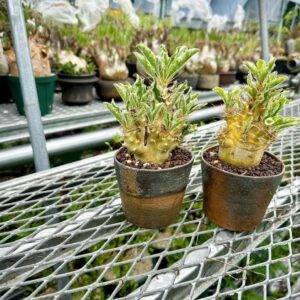Lophophora williamsii: The Complete Guide to Peyote Cactus
Lophophora williamsii, commonly known as peyote, is a small, intriguing cactus native to the desert regions of northern Mexico and Texas. It has fascinated botanists, ethnobotanists, and plant enthusiasts alike for centuries due to its unique appearance, cultural significance, and psychoactive properties. This article will provide an in-depth overview of the plant, including its description, habitat, cultivation care, propagation methods, and legal status.
What is Lophophora williamsii?
Lophophora williamsii is a spineless, button-like cactus species in the family Cactaceae. It is characterized by its small, rounded, almost flat stems that range from 2 to 7 centimeters tall and 4 to 10 centimeters wide. The cactus surface is typically bluish-green to olive, segmented into ribs (usually between 5 and 13), with each rib topped by tufts of woolly, yellowish hairs. Unlike many cacti, it lacks sharp spines, making it appear smooth and soft.
The plant produces small funnel-shaped flowers ranging from white to pale pink with numerous petals, which bloom mainly during spring and summer. These flowers eventually develop into elongated pink berries containing black, pear-shaped seeds.

Ethnobotanical Significance and Psychoactive Properties
Lophophora williamsii holds a sacred status in Indigenous cultures, especially among Native American tribes such as the Huichol and the Tarahumara. The cactus contains mescaline and other alkaloids like lophophorine that produce strong hallucinogenic effects when ingested. Traditionally, the dried buttons (the above-ground part of the cactus) are chewed or brewed into teas and used in rituals to induce spiritual experiences, healing, and communication with the divine.
Due to its psychoactive nature, peyote is federally regulated in many countries. In the US, possession and use require special permits under the American Indian Religious Freedom Act. Overharvesting and habitat loss have made the species vulnerable in its native range.
Natural Habitat and Distribution
Lophophora williamsii is native to the Chihuahuan Desert region, primarily stretching across northern Mexico’s states and into southwestern Texas. It thrives in arid, limestone-rich, and gravelly soils at elevations between 100 to 1,500 meters. The plant prefers environments with well-drained, mineral-dense soils typical of desert scrublands.
The cactus adapts to seasonal changes, including monsoonal rains, by relying on a large underground taproot that stores water. During dry periods, the cactus can retract partially below the soil surface to conserve moisture.
How to Grow Lophophora williamsii: Care Tips
Light and Temperature
Peyote prefers bright, indirect sunlight or partial shade. While it can tolerate several hours of direct sun, especially morning sun, intense midday heat might require some shading. Ideal growing temperatures range from 20°C to 35°C (68°F to 95°F). The cactus can survive brief cold snaps down to about 4°C (39°F) but should be protected from frost.
Soil Requirements
The soil must be extremely well-draining to prevent root rot. A cactus mix with a high proportion of pumice, grit, or mineral gravel is recommended. The soil pH is commonly alkaline due to the limestone content in its native habitat. Avoid heavy, compacted soils that retain moisture.
Watering Schedule
Watering should be moderate and carefully managed. During the growing season (spring and summer), water the cactus once or twice a week, ensuring the soil dries out completely between waterings. Reduce watering significantly in the cooler months, allowing the plant to rest. Overwatering is a common cause of failure in cultivation.
Fertilization
During the active growth period, apply a diluted, low-nitrogen liquid fertilizer monthly or a slow-release cactus fertilizer. It’s important not to over-fertilize, as peyote grows slowly and thrives in nutrient-poor conditions resembling its native environment.
Humidity and Air Circulation
Peyote prefers low humidity typical of deserts. Good air circulation is essential to avoid fungal or bacterial diseases.
Propagation Methods
Seed Propagation
Growing peyote from seeds is the most natural method. Seeds are tiny and should be sown on the surface of a well-draining cactus substrate. Keep the soil lightly moist and warm at around 25-35°C (77-95°F). Germination can occur within 2 weeks but sometimes takes longer. Seedlings grow very slowly and prefer indirect light initially.
Cuttings and Grafting
While less common, Lophophora williamsii can be propagated by cuttings or grafted onto faster-growing rootstocks to accelerate flowering and maturity. Grafting can reduce the time to reach flowering size from decades in the wild to just a few years under controlled conditions.
Common Challenges and Solutions
-
Overwatering and Root Rot: Ensure soil dries between watering and use porous substrates.
-
Slow Growth: Peyote is naturally slow-growing. Patience is required.
-
Pests: Watch for mealybugs and fungal infections.
-
Temperature Stress: Protect from frost and excessive heat without shade.
Legal Status and Conservation
The psychoactive alkaloids in peyote make it a controlled species in many countries. It is illegal to possess, cultivate, or harvest without permits in places like the United States, Canada, and parts of Europe. Conservation efforts are ongoing to protect its natural populations, which face threats from habitat destruction and overharvesting for traditional and commercial use.
Summary
Lophophora williamsii is a fascinating cactus with a unique blend of botanical, cultural, and spiritual significance. Despite its challenges in cultivation and stringent legal protections, it remains a prized plant for specialized collectors and researchers. With the right knowledge about its habitat and care requirements, peyote can be successfully grown and appreciated outside its native desert home.







Reviews
There are no reviews yet.